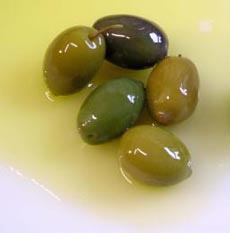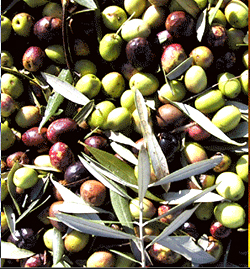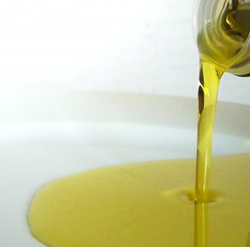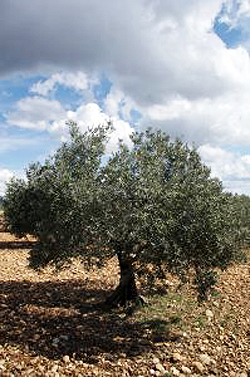

Olive oil is pressed from the fresh-picked fruit of the olive tree. Photo by Iliana | SXC.
November 2005
Updated June 2009
|
 |
Olive Oil & Olives Glossary
Page 7: Terms With N & O
This is Page 7 of the Olive Oil & Olives Glossary. If you think we should consider terms or definitions than those we have provided, use the Contact Us links on this page. Also read our article, Flavors and Aromas of Olive Oil. Visit our collection of 60+ food glossaries to learn more about other food products.
You can click on the letter of the alphabet in the bar below to get to a term
without having to scroll manually.
a b c d e f g h i j k l m n o p q r s t u v w x y z
This glossary is protected by copyright and cannot be reproduced in whole or part.
NAFPLION OLIVE
Named for the coastal town of Nafplio, Greece, a seaport town on the eastern side of the Peloponnesus peninsula (and the first capital of modern Greece, from 1829 to 1834—Kalamata is on the southern side of the peninsula). This fragrant, small, firm-fleshed olive is used in appetizers, as a topping on fish dishes, as a garnish and served with an aperitif. It is both a table olive (it has a nutty flavor) and is pressed into Nafplion olive oil, a delicate, gourmet salad oil.
NIÇOISE OLIVE
This fragrant, firm-fleshed olive is added to fish dishes and served with an aperitif. Serve it with a light dry or fruity white wine, from Sancerre to Pinot Grigio.
OIL
A fat that is liquid at room temperature.
OLIVE
The stone fruit of the olive tree, Olea europaea L. Within this genus, there are many different varieties of olives throughout the world. Small and round, the stone or pit is  surrounded by the flesh or meat. Olives vary in color from bright green to black, depending on ripeness when the fruit was picked. Olives are mainly used to produce olive oil or for eating as an appetizer, an addition to a relish tray or as an ingredient added to sandwiches, pizza, salads and other dishes. About 10 pound of olives are provided to produce one quart of oil. The average olive tree produces enough fruit to make three quarts of oil, although some trees produce three times as much. Olive trees require a Mediterranean-type climate: mild winters, hot summers. They are grown in Algeria, Argentina, Australia, Chile, Croatia, Cyprus, France, Greece, Italy, Israel, Jordan, Morocco, New Zealand, Portugal, Slovenia, South Africa, Spain, Syria, Turkey, Tunisia, and the United States. surrounded by the flesh or meat. Olives vary in color from bright green to black, depending on ripeness when the fruit was picked. Olives are mainly used to produce olive oil or for eating as an appetizer, an addition to a relish tray or as an ingredient added to sandwiches, pizza, salads and other dishes. About 10 pound of olives are provided to produce one quart of oil. The average olive tree produces enough fruit to make three quarts of oil, although some trees produce three times as much. Olive trees require a Mediterranean-type climate: mild winters, hot summers. They are grown in Algeria, Argentina, Australia, Chile, Croatia, Cyprus, France, Greece, Italy, Israel, Jordan, Morocco, New Zealand, Portugal, Slovenia, South Africa, Spain, Syria, Turkey, Tunisia, and the United States.
Photo of green olives courtesy of OliveOil.com.
- Spain, Italy, and Greece represent more than three-fourths of the total olive oil output in the world. Rounding out the Top 10 are Turkey, Syria, Tunisia, Morocco, Egypt, Algeria and Portugal (2003 production/tons).
- Spain supplies 1/3 of the world’s olive oil, Italy 1/4, and Greece 1/5.
The olive was first referenced in print in Egypt in the 17th century B.C.E. It is mentioned numerous times in the Bible. Our word “olive” comes from the Latin olivea, which first appeared in English around 1200 C.E. There are hundreds of varieties of olive. Some, such as the Chemalali, Corregiolo, Leccino, Picual and Zorzalina, are grown primarily for oil extraction. Other varieties, such as the Amygdalolia, Ascolano, Karydolia, Manzanillo, Misson and Sevillano, are used principally as table olives. Generally, the name of the olive denotes the location where it originated or was grown, e.g., the Mytilini olive, grown in Mytilini, the capital of Lesvos, a Greek island in the Aegean Sea. In addition to place of origin, olives may also be named for the type of cure, the type of marinade used after the cure, or the cultivar name of the olive tree on which the fruit is grown. When olives are first picked from the tree, they are inedible because of the glucoside in their flesh. Once the glucoside is leached from the flesh through a curing process, the olives become edible. Olives are stored in brine or are salted to preserve them. See also olive tree.
OLIVE CAKE
IOOC Definition: Olive cake is the solid phase that remains after pressing olives. Also called pomace or sansa.
OLIVE BREAD
A Mediterranean sourdough loaf traditionally made with whole pitted or chopped black olives, such as dried Greek olives or Kalamata olives, to give strong olive flavor to the bread. A variety of recipes have evolved, using olive paste (tapenade) to flavor the entire loaf, using green olives and a mixture of black and green olives.
OLIVE OIL - GENERAL
The pressing of olives to make olive oil dates back to about 3000 B.C.E. The oil produced from manual or machine pressing of the fruit of the olive tree (olives). The flavor and color of the olive oil produced from the same variety of olive may vary significantly from one region to the next, even from grower to grower in the same region, since, as with wine grapes, the soil and microclimate (“terroir”) create different flavors within fruit. (That refers to fine olive oil which represents perhaps the top 10%  of production.) At the time of harvest, the maturity of the fruit and the extraction process also affect the color and taste. Flavors range from mild, buttery, citrusy and herbal to spicy, tart, and somewhat peppery tasting. There are four basic grades of olive oil readily available in food stores: extra virgin (from the first pressing of olives); virgin (the second pressing); olive oil or pure olive oil (minimally processed), and extra light (heavily processed). Compared with other oils, olive oil contains one of the highest percentages of monounsaturated fat. This type of fat is known to influence blood cholesterol by lowering low-density lipoproteins (LDLs or “bad cholesterol”), while protecting or raising the beneficial high-density lipoprotein (HDL) cholesterol. Olive oil should be stored in a dry, dark area and should not be exposed to excessive heat. Bottled oils can be kept for a year before they begin to loose their flavor. However, it is best to buy no more than you expect to use within six months. Today, about one-third of the world’s olive oil comes from the Andalusia region of southern Spain. of production.) At the time of harvest, the maturity of the fruit and the extraction process also affect the color and taste. Flavors range from mild, buttery, citrusy and herbal to spicy, tart, and somewhat peppery tasting. There are four basic grades of olive oil readily available in food stores: extra virgin (from the first pressing of olives); virgin (the second pressing); olive oil or pure olive oil (minimally processed), and extra light (heavily processed). Compared with other oils, olive oil contains one of the highest percentages of monounsaturated fat. This type of fat is known to influence blood cholesterol by lowering low-density lipoproteins (LDLs or “bad cholesterol”), while protecting or raising the beneficial high-density lipoprotein (HDL) cholesterol. Olive oil should be stored in a dry, dark area and should not be exposed to excessive heat. Bottled oils can be kept for a year before they begin to loose their flavor. However, it is best to buy no more than you expect to use within six months. Today, about one-third of the world’s olive oil comes from the Andalusia region of southern Spain.
Photo by Greschoj | SXC.
OLIVE OIL - GRADE (also called PURE OLIVE OIL)
The olive oil grade known simply as olive oil is a refined (processed) oil with virgin or extra virgin oil added. This grade of oil is the lowest of the three consumer grades, the least expensive, and the most widely used for cooking. Generally, refined olive oil needs to have a percentage of virgin or extra virgin olive oil added to provide some pleasing color, flavor, and aroma characteristics, as refined olive oil has no or very little taste or smell. Products labeled “Olive Oil” or “Pure Olive Oil” usually have a ratio of 85% refined oil to 15% virgin or extra virgin oil. The maximum acidity level of “Olive Oil” may not exceed 1.5% (after the addition of the virgin or extra virgin oil). Depending on the producer, this type of oil may be labeled as “Olive Oil,” “Pure Olive Oil,” or “100% Olive Oil,” indicating that no other types of oil have been added. The refined oils may also be labeled as “Mild Olive Oil” or “Light Olive Oil.” The “Olive Oil” grade has the same health benefits of the higher quality virgin and extra virgin grades. It also has a higher smoke point than virgin or extra virgin oil, making it the best choice for cooking. See also refined oil.
OLIVE PASTE
After the fruit is harvested and washed, it is crushed and ground into olive paste, and pressed to extract the oil.
OLIVE TREE
The olive is a subtropical, broad-leaved evergreen tree (Olea europea L.), grown for the production of its fruits which are utilized for table olives and for the extraction of the  olive oil. It is a member of the family Oleaceae, which also includes the privet, lilac, ash, forsythia and jasmine. The origin of the edible olive, Olea europaea, is lost in ancient history. It was probably first collected wild in the eastern Mediterranean or south central Asia. Certainly it is one of the oldest cultivated crops: it was an olive leaf that the dove brought to Noah’s ark. There is evidence that the olive was grown on the island of Crete about 3500 B.C.E. The Semitic people apparently cultivated it as early as 3000 B.C.E. Olive oil was a highly prized luxury for anointing the body in Greece during the time of Homer, about 900 B.C.E., and it was an important crop of the Romans around 600 B.C.E. In subsequent times, olive growing spread to all other countries bordering the Mediterranean. The olive tree is relatively slow-growing but very long-lived, some specimens reportedly being more than 1,000 years old. There are at least five natural subspecies: Olea europaea, subspecies europaea (Europe); Olea europaea subspecies cuspidata (Iran to China); Olea europaea, subspecies guanchica (Canary Islands); Olea europaea, subspecies maroccana (Morocco); Olea europaea, subspecies laperrinei (Algeria, Sudan, Niger). olive oil. It is a member of the family Oleaceae, which also includes the privet, lilac, ash, forsythia and jasmine. The origin of the edible olive, Olea europaea, is lost in ancient history. It was probably first collected wild in the eastern Mediterranean or south central Asia. Certainly it is one of the oldest cultivated crops: it was an olive leaf that the dove brought to Noah’s ark. There is evidence that the olive was grown on the island of Crete about 3500 B.C.E. The Semitic people apparently cultivated it as early as 3000 B.C.E. Olive oil was a highly prized luxury for anointing the body in Greece during the time of Homer, about 900 B.C.E., and it was an important crop of the Romans around 600 B.C.E. In subsequent times, olive growing spread to all other countries bordering the Mediterranean. The olive tree is relatively slow-growing but very long-lived, some specimens reportedly being more than 1,000 years old. There are at least five natural subspecies: Olea europaea, subspecies europaea (Europe); Olea europaea subspecies cuspidata (Iran to China); Olea europaea, subspecies guanchica (Canary Islands); Olea europaea, subspecies maroccana (Morocco); Olea europaea, subspecies laperrinei (Algeria, Sudan, Niger).
Photo of olive tree by Christoph van de Bij | SXC.
100% OLIVE OIL or PURE OLIVE OIL
A labeling that indicates only that the contents are 100% olive oil, i.e. that no other types of oil have been added. It does not indicate quality. It is a blend of refined oil and virgin or extra virgin olive oil. See also refined oil.
ORGANIC OLIVE OIL
Oils that are organically-certified carry the USDA green-and-white organic seal. However,  numerous U.S. growers have farmed organically for generations: they simply are too small or do not wish to invest the time and money to pursue organic certification. Their labels will speak to organic practices without bearing the USDA ORGANIC seal. International oils that are products of organic farming or organically grown and/or are certified organic by agencies are identified as “Da Agricoltura Biologica” (Italian), “Agricultura Ecologica” (Spanish), and “Produto De Agricultura Biológica” (Portuguese). One oil, the Portuguese CARM, is said to be certified organic according to USDA standards, by a USDA-approved agency, but you will not find the typical green-and-white seal anywhere on its label. numerous U.S. growers have farmed organically for generations: they simply are too small or do not wish to invest the time and money to pursue organic certification. Their labels will speak to organic practices without bearing the USDA ORGANIC seal. International oils that are products of organic farming or organically grown and/or are certified organic by agencies are identified as “Da Agricoltura Biologica” (Italian), “Agricultura Ecologica” (Spanish), and “Produto De Agricultura Biológica” (Portuguese). One oil, the Portuguese CARM, is said to be certified organic according to USDA standards, by a USDA-approved agency, but you will not find the typical green-and-white seal anywhere on its label.
ORGANOLEPTIC
Perceived by the sensory organs. The organoleptic properties of olive oil are color, bouquet and taste.
Continue To Next Page: Terms With P & R
Go To The Article Index Above
Lifestyle Direct, Inc. All rights reserved. Images are the copyright of their individual owners.

|
|





 surrounded by the flesh or meat. Olives vary in color from bright green to black, depending on ripeness when the fruit was picked. Olives are mainly used to produce olive oil or for eating as an appetizer, an addition to a relish tray or as an ingredient added to sandwiches, pizza, salads and other dishes. About 10 pound of olives are provided to produce one quart of oil. The average olive tree produces enough fruit to make three quarts of oil, although some trees produce three times as much. Olive trees require a Mediterranean-type climate: mild winters, hot summers. They are grown in Algeria, Argentina, Australia, Chile, Croatia, Cyprus, France, Greece, Italy, Israel, Jordan, Morocco, New Zealand, Portugal, Slovenia, South Africa, Spain, Syria, Turkey, Tunisia, and the United States.
surrounded by the flesh or meat. Olives vary in color from bright green to black, depending on ripeness when the fruit was picked. Olives are mainly used to produce olive oil or for eating as an appetizer, an addition to a relish tray or as an ingredient added to sandwiches, pizza, salads and other dishes. About 10 pound of olives are provided to produce one quart of oil. The average olive tree produces enough fruit to make three quarts of oil, although some trees produce three times as much. Olive trees require a Mediterranean-type climate: mild winters, hot summers. They are grown in Algeria, Argentina, Australia, Chile, Croatia, Cyprus, France, Greece, Italy, Israel, Jordan, Morocco, New Zealand, Portugal, Slovenia, South Africa, Spain, Syria, Turkey, Tunisia, and the United States.  of production.) At the time of harvest, the maturity of the fruit and the extraction process also affect the color and taste. Flavors range from mild, buttery, citrusy and herbal to spicy, tart, and somewhat peppery tasting. There are four basic grades of olive oil readily available in food stores: extra virgin (from the first pressing of olives); virgin (the second pressing); olive oil or pure olive oil (minimally processed), and extra light (heavily processed). Compared with other oils, olive oil contains one of the highest percentages of monounsaturated fat. This type of fat is known to influence blood cholesterol by lowering low-density lipoproteins (LDLs or “bad cholesterol”), while protecting or raising the beneficial high-density lipoprotein (HDL) cholesterol. Olive oil should be stored in a dry, dark area and should not be exposed to excessive heat. Bottled oils can be kept for a year before they begin to loose their flavor. However, it is best to buy no more than you expect to use within six months. Today, about one-third of the world’s olive oil comes from the Andalusia region of southern Spain.
of production.) At the time of harvest, the maturity of the fruit and the extraction process also affect the color and taste. Flavors range from mild, buttery, citrusy and herbal to spicy, tart, and somewhat peppery tasting. There are four basic grades of olive oil readily available in food stores: extra virgin (from the first pressing of olives); virgin (the second pressing); olive oil or pure olive oil (minimally processed), and extra light (heavily processed). Compared with other oils, olive oil contains one of the highest percentages of monounsaturated fat. This type of fat is known to influence blood cholesterol by lowering low-density lipoproteins (LDLs or “bad cholesterol”), while protecting or raising the beneficial high-density lipoprotein (HDL) cholesterol. Olive oil should be stored in a dry, dark area and should not be exposed to excessive heat. Bottled oils can be kept for a year before they begin to loose their flavor. However, it is best to buy no more than you expect to use within six months. Today, about one-third of the world’s olive oil comes from the Andalusia region of southern Spain. olive oil. It is a member of the family Oleaceae, which also includes the privet, lilac, ash, forsythia and jasmine. The origin of the edible olive, Olea europaea, is lost in ancient history. It was probably first collected wild in the eastern Mediterranean or south central Asia. Certainly it is one of the oldest cultivated crops: it was an olive leaf that the dove brought to Noah’s ark. There is evidence that the olive was grown on the island of Crete about 3500 B.C.E. The Semitic people apparently cultivated it as early as 3000 B.C.E. Olive oil was a highly prized luxury for anointing the body in Greece during the time of Homer, about 900 B.C.E., and it was an important crop of the Romans around 600 B.C.E. In subsequent times, olive growing spread to all other countries bordering the Mediterranean. The olive tree is relatively slow-growing but very long-lived, some specimens reportedly being more than 1,000 years old. There are at least five natural subspecies: Olea europaea, subspecies europaea (Europe); Olea europaea subspecies cuspidata (Iran to China); Olea europaea, subspecies guanchica (Canary Islands); Olea europaea, subspecies maroccana (Morocco); Olea europaea, subspecies laperrinei (Algeria, Sudan, Niger).
olive oil. It is a member of the family Oleaceae, which also includes the privet, lilac, ash, forsythia and jasmine. The origin of the edible olive, Olea europaea, is lost in ancient history. It was probably first collected wild in the eastern Mediterranean or south central Asia. Certainly it is one of the oldest cultivated crops: it was an olive leaf that the dove brought to Noah’s ark. There is evidence that the olive was grown on the island of Crete about 3500 B.C.E. The Semitic people apparently cultivated it as early as 3000 B.C.E. Olive oil was a highly prized luxury for anointing the body in Greece during the time of Homer, about 900 B.C.E., and it was an important crop of the Romans around 600 B.C.E. In subsequent times, olive growing spread to all other countries bordering the Mediterranean. The olive tree is relatively slow-growing but very long-lived, some specimens reportedly being more than 1,000 years old. There are at least five natural subspecies: Olea europaea, subspecies europaea (Europe); Olea europaea subspecies cuspidata (Iran to China); Olea europaea, subspecies guanchica (Canary Islands); Olea europaea, subspecies maroccana (Morocco); Olea europaea, subspecies laperrinei (Algeria, Sudan, Niger). numerous U.S. growers have farmed organically for generations: they simply are too small or do not wish to invest the time and money to pursue organic certification. Their labels will speak to organic practices without bearing the USDA ORGANIC seal. International oils that are products of organic farming or organically grown and/or are certified organic by agencies are identified as “Da Agricoltura Biologica” (Italian), “Agricultura Ecologica” (Spanish), and “Produto De Agricultura Biológica” (Portuguese). One oil, the Portuguese CARM, is said to be certified organic according to USDA standards, by a USDA-approved agency, but you will not find the typical green-and-white seal anywhere on its label.
numerous U.S. growers have farmed organically for generations: they simply are too small or do not wish to invest the time and money to pursue organic certification. Their labels will speak to organic practices without bearing the USDA ORGANIC seal. International oils that are products of organic farming or organically grown and/or are certified organic by agencies are identified as “Da Agricoltura Biologica” (Italian), “Agricultura Ecologica” (Spanish), and “Produto De Agricultura Biológica” (Portuguese). One oil, the Portuguese CARM, is said to be certified organic according to USDA standards, by a USDA-approved agency, but you will not find the typical green-and-white seal anywhere on its label.